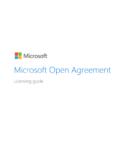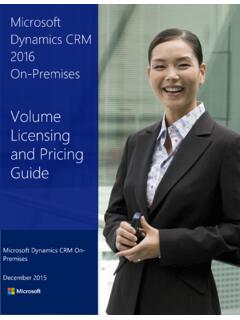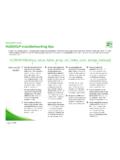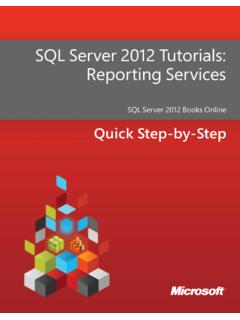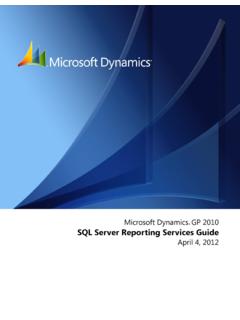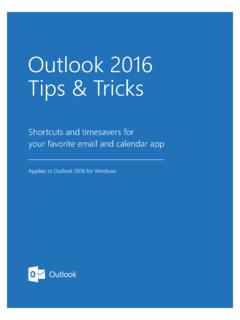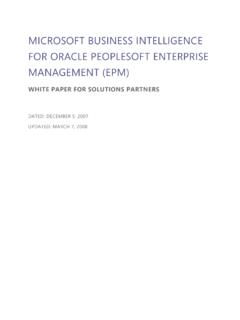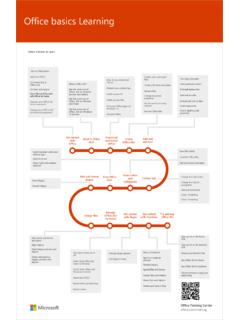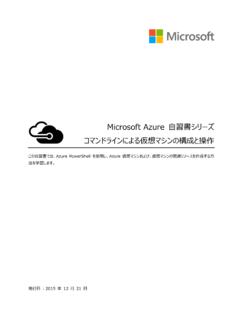Transcription of Multiplexing Client Access License (CAL) requirements
1 Volume Licensing brief Multiplexing Client Access License (CAL). requirements This brief applies to all Microsoft Volume Licensing programs. Table of contents 1. What's new in this brief .. 1. Details .. 1. Microsoft SQL Server .. 2. Project Server .. 3. Microsoft Visual Studio Team Foundation Server .. 4. Frequently asked questions .. 5. Summary This brief explains how Multiplexing impacts the licensing of Microsoft server operating systems and server products licensed under the Microsoft server/ Client Access License (CAL) model.
2 Multiplexing is when customers use hardware or software to pool connections, reroute information, or reduce the number of devices or users that directly Access or use a product. Multiplexing can also include reducing the number of devices or users a product directly manages. What's new in this brief This brief replaces a previous version published in March 2014. There have been no licensing changes with this update. Details Multiplexing does not reduce the number of Microsoft licenses required. Users are required to have the appropriate licenses, regardless of their direct or indirect connection to the product.
3 Any user or device that accesses the server, files, or data or content provided by the server that is made available through an automated process requires a CAL. Certain circumstances do not require CALs, and they are detailed below. Generally, if files, data, or content are available because of manual activity (a person uploading a file onto a server or emailing the file), a CAL is not required for users or devices accessing those manually transmitted files. Multiplexing Client Access License (CAL) requirements The following examples address specific products, but the same requirements apply to other Microsoft products.
4 Assume that the Windows Server operating system and Microsoft Exchange Server are the networking and messaging platforms respectively. Microsoft SQL Server Figures 1, 2, and 3 illustrate representative Multiplexing scenarios and licensing requirements for the Microsoft SQL Server database software. (Note: Windows Server and Exchange Server CAL requirements apply for any Access either direct or indirect to these servers.). Figure 1: Inputting, querying, or viewing data SQL Server CALs are required for users who directly input into, query, or view data from a SQL Server database (left side of Figure 1).
5 Similarly, SQL Server CALs are required for users or devices that input data into, query, or view data from a SQL Server database through a pooling device (right side of Figure 1). This includes users who view data through web-based applications or enter information into a database through an intermediary product. (Note: Customers can also License SQL Server on a per-core basis, thus negating any need for SQL Server CALs.). Figure 2: Messaging data If a user (User 1 in Figure 2 above) retrieves data from SQL Server, that user requires a SQL Server CAL.
6 If User 1 actively sends that data by email or other messaging technology to User 2; then User 2 does not require a SQL Server CAL. With Multiplexing , these rules do not change. User 3, who receives data through a pooling application, must similarly have a SQL Server CAL. If User 3 actively sends that data by email or other messaging technology to User 4, then User 4 does not require a SQL Server CAL. December 2018 2. Multiplexing Client Access License (CAL) requirements Figure 3: Hardcopy delivery of data The paper distribution of data does not require SQL Server CALs for the recipients of the paper report.
7 However, both User 1 and User 3. in the figure above receive data (directly or indirectly) from SQL Server and both require CALs. If each user prints the data and delivers it to another user (Users 2 and 4), these latter recipient users do not require a SQL Server CAL. A printer connected directly to the server does not require a License to print data from the server, nor is a printer considered a Multiplexing device. Project Server Figure 4 illustrates some Multiplexing scenarios and licensing requirements for Project Server.
8 (Note: Windows Server and SQL Server [if licensed Server/CAL] CAL requirements apply for any Access either direct or indirect to these servers.). December 2018 3. Multiplexing Client Access License (CAL) requirements Figure 4: Basic Project Server configuration Viewing or querying data from or entering data into Project Server through an intermediary Multiplexing application, which could include a web-based application, requires CALs for Project Server. Like SQL Server, the same CAL requirements apply for the messaging of data through email or paper distribution shown in the examples above.
9 Microsoft Visual Studio Team Foundation Server As with SQL Server and other products in the Microsoft server/CAL licensing model, applying Multiplexing rules to CAL requirements for Microsoft Visual Studio Team Foundation Server depends on the degree of automation involved in content, file, or data accessibility and distribution. Any device/user that accesses or deploys files, content, and data that is made available in an automated way (for example, directly from a server or automatically posted to a server) requires a CAL.
10 However, if the availability results from manual activity, such as a person loading files onto a server or emailing the files, a CAL is not required for users and/or devices accessing those manually posted or emailed files. The following examples illustrate the Visual Studio Team Foundation Server CALs required. (The CAL requirements for other server products used with Visual Studio Team Foundation Server still apply for any Access either direct or indirect to the server.). Example 1. An automated process is set up to load files from a server running Visual Studio Team Foundation Server to a server farm, and then that server farm automatically loads those files onto desktops.
